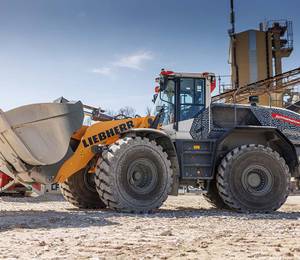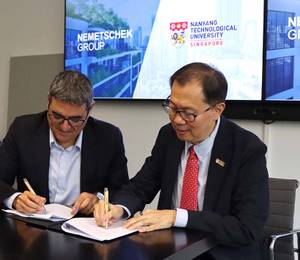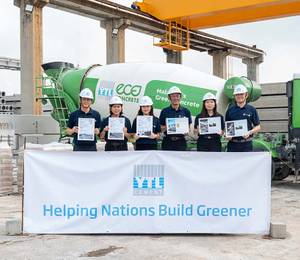Tadano has launched two new hybrid all-terrain cranes, which feature a battery electric superstructure. The AC 4.070HL-1 is the market-ready version of the four-axle 70-t crane that was showcased as a tech demo back in 2022. Since then, the unit has undergone both testing and real-life use. The 120-t AC 5.120H-1 is the next model in the series and was recently presented at bauma 2025.
The ‘Tadano Green Solutions’ (TGS) environmental protection strategy has an objective of reducing the company’s CO2 emissions between 2019 and 2030 by 25% worldwide. Over the same period, Tadano aims to cut CO2 emissions from the use of its products by 35%. The goal is to be completely climate neutral by 2050.
According to Tadano, an important step towards its sustainability goal is the development of the hybrid crane solutions, which generate about 60% less CO2 than diesel-powered superstructures. The company said electric crane operation offers a system efficiency of around 85%, representing more than double the energy efficiency of an efficient diesel engine.
Flexible power options
A combination of conventional travel and fully electric on-site operation is made possible by these new hybrid models. More specifically, the carrier’s diesel engine is responsible for bringing the crane to the jobsite, where the engine can then be switched off for the duration of the work once the outriggers have been deployed.
Meanwhile, the high-voltage (HV) battery in the superstructure powers an electric motor, as well as the thermal management system and the superstructure cab’s air conditioning. The electric motor powers the hydraulic system used for crane operation, all with zero restrictions on the corresponding performance.
The hybrid cranes can be operated both self-sufficiently with their own battery power and with the support of an external power source, such as temporary jobsite power. The latter not only extends a unit’s multi-hour electric runtime, but can also relieve the load on the HV battery.
In addition, the hybrid cranes remain fully operational even when the HV battery is fully depleted and no external power supply is available. This is thanks to a generator that is driven by a power take-off on the carrier’s diesel engine and that charges the HV battery and allows for continued crane operation.
Various applications
Crane owners and rental companies benefit directly from reduced operating costs as a result of the maintenance-free electric motor and the elimination of the superstructure diesel engine. With the electric motor, there are no exhaust emissions anymore and the vibration and noise are kept to a minimum, all of which is coupled with continuous heating and air conditioning even in standby mode.
Some applications suitable for the hybrid cranes include:
-
Use in indoor areas (e.g. buildings in the event, manufacturing and logistics industries).
-
Use in outdoor areas sensitive to exhaust and noise emissions (e.g. urban areas, hospital grounds, zoos, nature reserves, or occupied residential buildings).
-
Use during quiet hours (at night, on Sundays and public holidays).
Versatile operating modes
A). Battery-only mode: The charged HV battery supplies all the power that the electric motor needs in order to drive the crane’s hydraulic pump. In this mode, the AC 4.070HL-1 can run for more than four hours with a full battery charge, while the AC 5.120H-1 can run for an entire working day under the same conditions.
B). Battery mode assisted by external power supply: During crane operation and pauses in operation, the HV battery is continuously recharged through the external power supply connected to the CEE vehicle inlet. Depending on the selected amperage, this makes continuous electric crane operation possible.
C). External-power-supply-only mode: Even if the HV battery is depleted, the crane can continue to work through its external power connection. Since the HV battery is also charged during pauses in crane operation, it can deliver levels of performance exceeding the externally supplied energy after charging briefly.
D). Battery mode assisted by generator: The carrier’s diesel engine charges the HV battery with the generator and the battery buffers the supplied power. Accordingly, the crane’s hydraulic system can briefly work with peak loads that are significantly greater than the maximum continuous power supplied by the generator.
The generator can be used during travel and when stationary, and can work in three operating modes: silent mode, eco mode and power mode. Thanks to the manual regenerative braking function, the generator can run when the vehicle is coasting during travel, saving fuel as a result. This reduces the load on the retarder and boosts the crane’s braking action.
E). Emergency operation: The crane can also be de-rigged with the 24-V vehicle electrical system, in which case the telescoping sections are retracted and the boom is lowered to its transport position.
The high-voltage system
The HV system on the AC 4.070HL-1 (up to 800 V) has been customised to perfectly match the power required by the unchanged hydraulic system. Among the highlights are:
-
HV battery pack: lithium-ion NMC (nickel manganese cobalt) battery.
-
Battery capacity: 70 kWh total capacity, of which approximately 80% is usable.
-
Electric motor: continuous output of 115 kW, peak torque of 1,200 Nm.
-
Generator: charging power >50 kW, continuous output of 85 kW, peak torque of 500 Nm.
-
Onboard charger: CEE vehicle inlet, 400 VAC, 63 A, limiting to 32 A possible.
-
Battery runtime: approximately 6.3 hr (load cycle 1), approximately 3.9 hr (load cycle 3).
-
Charging time with onboard charger (63 A): 10% to 90% state of charge (SoC) in approximately 1 hr.
-
Charging time with generator while working at jobsites: 10% to 90% SoC in approximately 1 hr.
-
Charging time with generator during travel: +55% SoC in approximately 1 hr.
The thermal management system ensures that the HV battery always works at its optimal operating temperature and that it will reach its optimal service life. The result is a high residual capacity of about 80% of the new battery’s SoH (state of health) even after 3,000 charging cycles. Partial charges only count towards these cycles proportionally and have a more positive effect on the battery’s lifespan the longer and more frequently the SoC remains in the middle range.
The hybrid crane design was planned in such a way as to be used across models, so that Tadano’s electrification for the AC 5.120H-1 is based directly on that of the AC 4.070HL-1. The front section of the five-axle crane’s superstructure supports an optional second HV battery pack. This doubling of the battery capacity to a total capacity of 140 kWh means that battery electric operation for a full working day without any external charging is possible.
Thanks to the optimised compact rear storage box next to the vehicle inlet, the machine can easily carry the usual crane equipment. The generator drive has been optimised further and runs maintenance-free directly off the transfer case between the second and third axles.















